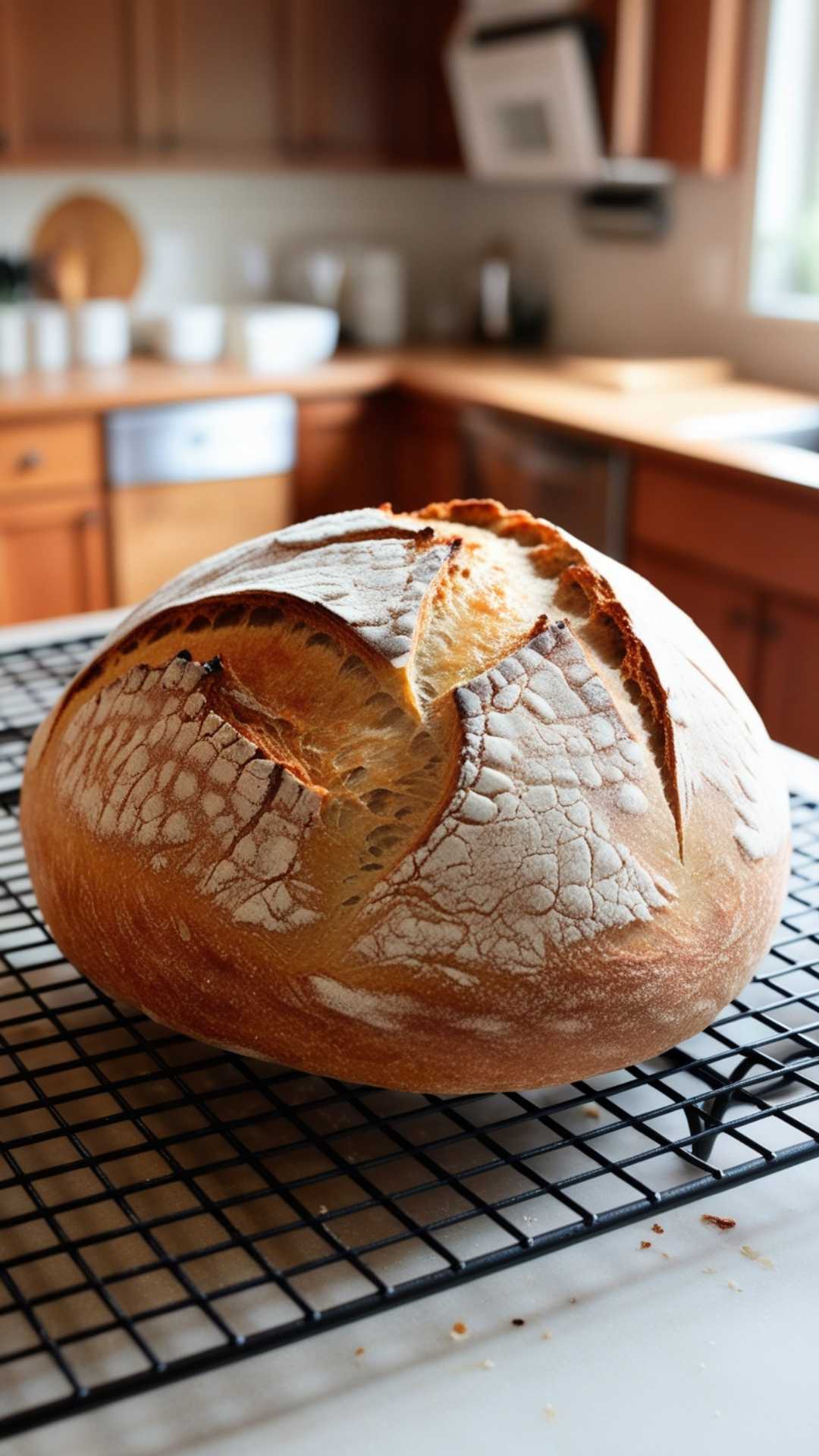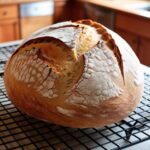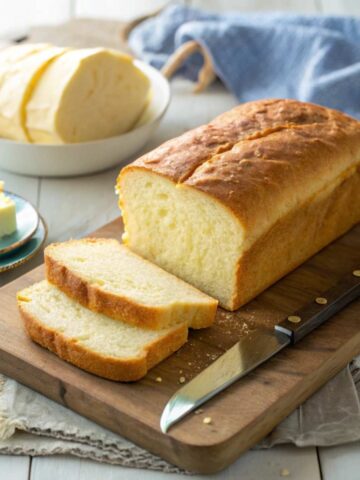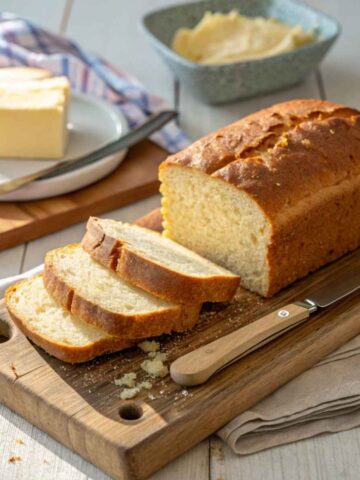Sourdough bread has been beloved for centuries thanks to its unique tangy flavor, chewy texture, and impressive shelf life. With the rise of gluten sensitivity and celiac disease awareness, the need for gluten-free alternatives has increased dramatically. Fortunately, gluten free sourdough bread offers a delicious, healthy option for those who need to avoid gluten but still crave sourdough's characteristic tang and texture.

Whether you have gluten intolerance or are simply looking for healthier, more natural bread options, gluten-free sourdough delivers all the flavors and benefits without gluten.
Jump to:
- What Is Sourdough Bread?
- The Magic of Fermentation
- How Gluten-Free Sourdough Differs
- The Challenge of Making Gluten-Free Sourdough Bread
- Critical Challenges in Gluten-Free Sourdough Baking
- Benefits of Gluten Free Sourdough Bread
- How to Make a Gluten-Free Sourdough Starter
- Serving Ideas for Gluten Free Sourdough Bread
- Storage Tips for Gluten Free Sourdough Bread
- Is Gluten-Free Sourdough Healthier?
- Where to Buy Gluten Free Sourdough Bread
- Conclusion
- FAQs
- Gluten Free Sourdough Bread
What Is Sourdough Bread?
Sourdough is different from your typical bread. Unlike most breads that use commercial yeast to rise, sourdough relies on a natural fermentation process. This process is fueled by a starter—a simple mixture of flour and water that captures wild yeast and lactobacilli (good bacteria) from the environment. Over time, this starter ferments, creating the natural leavening agents that give sourdough its rise and characteristic flavor.
The Magic of Fermentation
The true heart of sourdough bread is its fermentation process. The wild yeast and bacteria in the starter break down the sugars in the dough, creating bubbles that help the bread rise naturally. This fermentation not only gives sourdough its tangy flavor but also aids in breaking down some of the gluten in regular sourdough, making it easier for many people to digest.
How Gluten-Free Sourdough Differs
Traditional sourdough bread is made from wheat flour, which contains gluten—a protein that gives bread its elasticity and structure. However, gluten-free sourdough uses alternative flours like rice, sorghum, and tapioca, which lack gluten's binding properties. As a result, gluten-free sourdough requires more careful ingredient selection and different techniques to achieve a good rise, chewy texture, and tangy flavor.
The Challenge of Making Gluten-Free Sourdough Bread
Baking gluten-free sourdough presents some unique challenges. Without gluten to provide structure and elasticity, gluten-free doughs tend to be denser and less pliable than traditional doughs. It can make getting a good rise and a light, airy crumb harder.
Critical Challenges in Gluten-Free Sourdough Baking
- Texture: Gluten gives traditional sourdough its distinctive chewiness and rise. This protein can also cause gluten-free doughs to turn dense and crumbly if they are not handled correctly.
- Fermentation: The fermentation process can be more challenging in gluten-free baking, as the dough may rise less or develop the same depth of flavor as traditional sourdough.
- Flavor: Sourdough's signature tangy flavor comes from the fermentation process, but achieving that same complexity in a gluten-free version can take more effort and time.
Benefits of Gluten Free Sourdough Bread
Even though baking gluten-free sourdough requires a bit more care, the effort is worthwhile because of the range of health benefits.
1. Easier Digestion
One of the main benefits of sourdough bread, even gluten-free varieties, is that it's easier to digest. It is mainly due to the fermentation process, which helps break down some of the carbohydrates and proteins in the flour, making them more accessible to the digestive system.
2. Gut Health
The fermentation process in sourdough creates probiotics, beneficial bacteria that support healthy digestion. These probiotics can improve gut health by helping maintain a healthy balance of bacteria in the digestive tract, which is essential for digestion and immune health.
3. Nutrient-Rich
Unlike store-bought gluten free bread, which often contains highly processed ingredients and preservatives, homemade gluten-free sourdough typically uses nutrient-dense, whole-grain flour. Flours like sorghum and brown rice are rich in fiber, vitamins, and minerals, making gluten-free sourdough a more nutritious choice.
Critical Ingredients for Gluten Free Sourdough Bread
Making a tremendous gluten-free sourdough starts with the right ingredients. Here are the key components that will help you achieve a delicious loaf.
1. Gluten-Free Flour
- Rice Flour is a common base for gluten-free bread. Its neutral flavor and fine texture make it ideal for bread dough.
- Sorghum Flour: Sorghum adds a slightly sweet, earthy flavor to the bread and is rich in fiber and antioxidants.
- Tapioca Starch: Tapioca helps give gluten-free bread some of the elasticity and chewiness that gluten provides in traditional bread.
2. Gluten-Free Sourdough Starter
A sourdough starter is the essential leavening agent for sourdough bread. It's a fermented mixture of gluten-free flour and water that captures wild yeast from the environment. Once established, a good starter can be used repeatedly for baking.
3. Binders
Since gluten-free dough lacks gluten's binding properties, you'll need to use other ingredients to hold the dough together:
- Xanthan Gum: A common thickener and stabilizer in gluten-free baking, xanthan gum helps provide the elasticity that gluten typically gives.
- Psyllium Husk: Psyllium husk is another fiber-rich ingredient that helps bind the dough and adds moisture, resulting in a better texture.
How to Make a Gluten-Free Sourdough Starter
Before baking gluten free sourdough bread, you must create a gluten-free sourdough starter. It takes about a week but is well worth the effort, as the starter will provide natural leavening and flavor for your bread.
Step-by-Step Guide to Creating a Gluten-Free Sourdough Starter
- Day 1: Combine ½ cup of gluten-free flour (such as brown rice flour) with ½ cup of filtered water in a clean jar. Stir to mix, cover loosely, and leave it at room temperature for 24 hours.
- Day 2: You should see a few bubbles, indicating fermentation has begun. Discard half the starter and feed it again with ½ cup of gluten-free flour and ½ cup of water. Stir, cover loosely, and leave it for another 24 hours.
- Days 3-7: Feed the starter daily by discarding half and replenishing it with fresh flour and water. After about a week, your starter should be bubbly and have a tangy, pleasant smell—it's ready to use.
Maintaining Your Starter
Once your starter is established, you can store it in the refrigerator and feed it weekly if you're not baking frequently. Before baking, please bring it to room temperature and give it a fresh feeding to re-activate the yeast.
Gluten Free Sourdough Bread Recipe
Now that your starter is ready, here's a step-by-step guide to making gluten free sourdough bread.
Ingredients:
- 1 ½ cups gluten-free sourdough starter
- 1 ½ cups brown rice flour
- 1 cup sorghum flour
- ½ cup tapioca starch
- 2 teaspoon xanthan gum
- 1 ½ teaspoon salt
- 1 ½ cups water
- 1 tablespoon olive oil (optional for a softer crust)
Instructions:
- Prepare the Dough: Combine the flour, xanthan gum, and salt in a large bowl. In a separate bowl, mix the starter with water and olive oil.
- Mix and Knead: Gradually add the wet ingredients to the dry mixture, stirring until a sticky dough forms. Knead the dough lightly to ensure it's well combined.
- First Rise: Cover the dough with a cloth and let it rise for 4-6 hours until it's doubled in size. Note that gluten-free dough won't rise as much as traditional dough, but you should still see some increase in volume.
- Shape the Loaf: Once the dough has risen, shape it into a round or oval loaf and place it on a parchment-lined baking sheet or in a greased loaf pan.
- Second Rise: Let the dough rise again for 1-2 hours. It should appear slightly puffed but will not double in size.
- Bake: Preheat your oven to 450°F (230°C). Bake the loaf for 45-50 minutes until the crust is golden brown and the loaf sounds hollow when tapped.
- Cool: Let the bread cool completely before slicing.
Common Mistakes to Avoid When Baking Gluten-Free Sourdough
Gluten-free sourdough can be tricky, especially if you're new to it. Avoid these common mistakes to get the best results:
1. Not Feeding the Starter Enough
Your starter needs regular feedings to stay active. To ensure it's strong enough to leaven your bread, give it fresh flour and water regularly, especially before baking.
2. Skipping Hydration
Gluten-free doughs tend to absorb more water than wheat-based doughs. If your dough seems too dry, don't be afraid to add more water.
3. Rushing the Fermentation
Sourdough requires patience. Give your dough plenty of time to rise—rushing the fermentation process can result in dense, flat bread.
Tips for Perfecting Gluten Free Sourdough Bread
Getting the perfect loaf of gluten free sourdough bread takes some practice, but these tips can help you along the way:
- Experiment with Flour Blends: Not all gluten-free flours behave the same. Try different combinations, like buckwheat or millet flour, to find the best for your taste and texture preferences.
- Pay Attention to Hydration: Gluten-free doughs need more water, so don't be afraid to adjust your liquid ratios.
- Give It Time: Longer fermentation leads to more flavor. For that tangy, deep sourdough taste, let your dough ferment overnight in the fridge for an extra boost of flavor.
Serving Ideas for Gluten Free Sourdough Bread
Once you've baked a perfect loaf, the possibilities for serving gluten-free sourdough are endless. Here are a few ideas:
- Toast with Avocado: A slice of gluten-free sourdough toast topped with mashed avocado, sea salt, and a drizzle of olive oil makes for a satisfying breakfast or snack.
- Perfect Pair for Soups: Sourdough's chewy texture makes it perfect for dipping into hearty soups like tomato or butternut squash.
- Classic Sandwich: Whether you prefer grilled cheese or a fresh turkey and avocado sandwich, gluten-free sourdough is up to hearty fillings.
Storage Tips for Gluten Free Sourdough Bread
To ensure your gluten-free sourdough stays fresh and delicious, it's crucial to store it the right way:
- At Room Temperature: Once cooled, store your bread in an airtight container at room temperature for up to three days. Avoid refrigerating, as this can cause the bread to dry out.
- Freezing: If you want to keep your bread longer, slice it before freezing. Tightly wrap each slice in plastic wrap and place them in a freezer-safe bag. Gluten-free sourdough can be frozen for up to three months.
- Reheating: To restore freshness, toast the bread lightly or warm it in the oven at 350°F (175°C) for 5-10 minutes.
Is Gluten-Free Sourdough Healthier?
Unlike store-bought gluten-free bread, often packed with preservatives and fillers, gluten-free sourdough tends to have a more straightforward, natural ingredient list. Here are some extra health benefits:
1. Easier to Digest
Fermentation breaks down some of the bread's starches and proteins, making them easier for the body to process.
2. More Nutrients
Sourdough fermentation helps reduce phytic acid, a compound inhibiting the absorption of minerals like iron and calcium. This means you're getting more nutrition out of each slice.
3. Cleaner Ingredients
Gluten-free sourdough is typically made with whole grains and contains fewer additives compared to most store-bought gluten-free breads.
Where to Buy Gluten Free Sourdough Bread
If you'd prefer to buy gluten-free sourdough rather than bake it yourself, here are some places to find it:
1. Local Bakeries
Many artisanal bakeries now offer gluten-free sourdough loaves, often available at farmers' markets or specialty bread shops.
2. Online Retailers
Several online retailers ship gluten-free sourdough straight to your door. Brands like Bread SRSLY, Simple Kneads, and New Cascadia Traditional are known for their gluten-free offerings.
3. Health Food Stores
Chains like Whole Foods and specialty health food stores often carry gluten-free sourdough in the fresh bread section or the freezer aisle.
Conclusion
Gluten free sourdough bread is a beautiful alternative to traditional bread, offering the same tangy flavor and satisfying texture without the gluten. While it may take patience and practice to master, the health benefits, easy digestion, and versatility of gluten-free sourdough make it well worth the effort. Whether you bake it yourself or pick up a loaf from a local bakery, gluten-free sourdough is a tasty, nutritious addition to your gluten-free lifestyle.
FAQs
The starter is essential for making traditional sourdough bread, including gluten-free versions. It's what gives the bread its rise and flavor.
Get ready to embark on a 24 to 48-hour journey, from creating the starter to fermenting the dough.
Thanks to the fermentation process, gluten-free sourdough can offer additional health benefits, like improved digestion and better nutrient absorption.
Gluten-free doughs can be thicker due to the lack of gluten. To prevent this, ensure your dough is adequately hydrated and allow plenty of time for fermentation.
Yes, gluten-free sourdough freezes well. Slice the bread before freezing so you can defrost individual slices as needed.

Gluten Free Sourdough Bread
- Total Time: 7 hours
- Yield: 12 slices 1x
Description
This gluten-free sourdough bread recipe delivers a tangy, chewy loaf perfect for those avoiding gluten. Made with a gluten-free sourdough starter, brown rice flour, sorghum flour, and tapioca starch, this bread is a delicious, healthy alternative to traditional sourdough.
Ingredients
- 1 ½ cups gluten-free sourdough starter
- 1 ½ cups brown rice flour
- 1 cup sorghum flour
- ½ cup tapioca starch
- 2 tsp xanthan gum
- 1 ½ tsp salt
- 1 ½ cups water
- 1 tbsp melted butter or coconut oil (optional for added moisture)
Instructions
- Prepare the Dough: In a large mixing bowl, combine the brown rice flour, sorghum flour, tapioca starch, xanthan gum, and salt. In a separate bowl, mix the gluten-free sourdough starter with water and melted butter or coconut oil.
- Mix and Knead: Slowly incorporate the wet ingredients into the dry mixture, stirring until the dough becomes sticky and fully mixed. Lightly knead the dough until it reaches a smooth consistency.
- First Rise: Cover the dough with a clean kitchen towel and let it rest for 4-6 hours in a warm spot until it increases in size. Gluten-free dough may not double, but it will become puffier.
- Shape the Loaf: Once the dough has risen, form it into your desired shape and place it on a baking sheet lined with parchment paper or directly in a well-oiled loaf tin.

- Second Rise: Let the shaped dough rise for another 1-2 hours, until it appears slightly more expanded and puffed.
- Bake: Preheat your oven to 450°F (230°C). Bake the bread for 45-50 minutes, or until the crust turns golden brown, and the loaf sounds hollow when tapped on the bottom.
- Cool: Transfer the loaf to a wire rack and let it cool down thoroughly before slicing it to ensure the best texture and taste.
Notes
Make sure your sourdough starter is bubbling and fully active before you begin baking. For a stronger tang, you can let the dough rise overnight in a cooler spot for a slow fermentation process.
- Prep Time: 10 minutes
- Cook Time: 50 minutes
- Category: Bread
- Cuisine: gluten-free
Nutrition
- Calories: 135
Keywords: Gluten-Free Bread, Gluten-Free Sourdough, Sourdough Bread









Leave a Reply